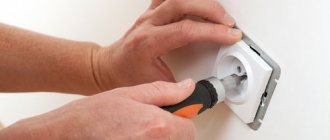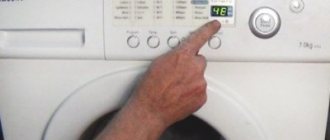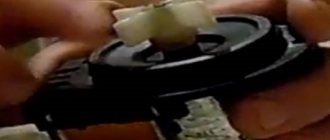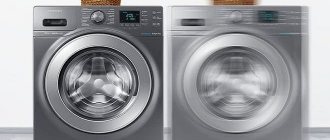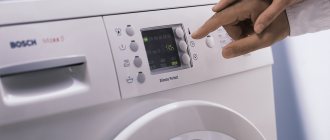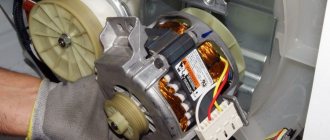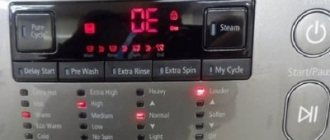Why does the drum rotate poorly?
In such a situation, you should definitely be concerned about the reasons for the breakdown. Based on this, the most suitable methods of repair work will be assigned. Often problems with element rotation include the following:
- Overload. Many modern washing machines that have special sensors do not start the process if there are too many items in the drum. When you suspect that you have overloaded the machine, it is recommended to cancel the program and take out a couple of things. This measure will allow the machine to continue operating as usual.
- Worn drive belt. In such a situation, rotation of the drum will only be possible by hand; the electric motor will not do this. However, the belt might not wear out, but simply fly off from the landing site.
- Electric motor brushes are worn out. In washing machines with commutator electric motors, this place is the most vulnerable. If the required motor maintenance has been performed over the entire period of operation, then there is a possibility that the brushes will have to be replaced. As a rule, after such a procedure, the machine’s ability to work is fully restored.
- The electronic programmer has failed. The most complex breakdown, because the work of reflashing or replacing the modular unit will require certain financial expenses.
- The electric motor is malfunctioning. When the drum rotates unevenly or does not rotate at all, the problem may lie in the electric motor. It probably broke, or a short circuit occurred - more likely problems in this situation. The repair is complex; it is recommended to hire an experienced specialist.
If the drum belt breaks
If the washing machine drum rotates slowly due to a broken belt, you need to find out the reason. Sometimes the belt can simply come off, for example, if too much laundry has been loaded. In other cases, this leads to more serious failures in the process:
- low quality drive belt;
- water entering directly onto the belt and resulting slippage;
- the drum pulley was removed;
- the bolt that attaches the engine to the drum is damaged or loosened;
- wear of the drum bearings, leading to the pulley rocking. In this case, you need to replace the bearing in the washing machine, as we discussed earlier;
- a small item of clothing getting stuck in the drum, which causes the belt to become too tight and may break. It's OK! Replacing a washing machine belt is easier than it sounds. See instructions at the link.
When checking the condition of the drive belt, the question arises: what is the permissible degree of its tension? It should be pulled with such force that when touched we can hear a ringing sound. However, overtightening will be unnecessary; there should be enough space on the sides so that it is possible to move the belt from one groove to another.
We figure out the problem ourselves
Primary diagnosis of breakdowns will be within the capabilities of any user. To do this, you must follow certain procedures:
- check the maximum weight of the laundry in the operating instructions;
- check that the door is not locked. As a rule, the drum stops spinning if the water drain filter is clogged;
- We try to turn the drum with our hands. If everything is normal, and a problem is observed during the automatic washing process, you should look for the cause in the wires, tachogenerator device, control module;
- It is imperative to inspect the cavity between the machine tank and the drum for the presence of foreign objects. If everything is normal, the heating element may have failed. The drum may also stop rotating due to a non-working heating element, thereby completely blocking the washing process;
- inspect the drive belt. It should be corrected or completely replaced with a new analogue;
- The machine is disassembled and inspected to see if there are any problems with the bearings. It is quite possible that they also need to be replaced.
What to do when the drum jams
For repairs, you don’t need much: an instruction manual, self-diagnosis to find out the causes of the breakdown, patience and several tools that can be found in the case of any home craftsman.
Replace brushes
If the reason is wear on the electric motor brushes, causing the drum to rotate slowly or slow down, you need to replace these elements. The repair consists of disassembling the SMA housing, removing the motor and installing brushes. The whole process is described in detail in the article “How to replace motor brushes” - there you will find step-by-step instructions with photos and videos.
For owners of Bosch washing machines, we have a separate instruction “How to replace brushes on a Bosch washing machine.”
Replace heating element
If the drum is jammed and the washing does not start at all, the problem is in the heater: you need to remove and replace the heating element. It could simply burn out, short out, or even explode.
In each brand, the heating element is removed in its own way: from the front or from the back. For example, in SM Bosch, Siemens and AEG, the heater is replaced exclusively from the front panel. And in other common models (Whirlpool, Ardo, Zanussi), to replace the heating element, just unscrew the back panel.
Replacing this part does not require any special repair skills, and your main task is to purchase an original analogue that matches your brand and model of washer. You will learn more about checking and replacing this element from the articles: “How to check the heating element” and “How to replace the heating element”.
We also have separate replacement instructions for owners of Indesit, Samsung, Bosch and LG washing machines.
Remove foreign object
If you notice that the drum rotates heavily or jerkily, sometimes sticks and jams, and is also accompanied by a knocking sound from the housing, it is quite possible that the problem is an object stuck between the walls of the tank and the drum.
To check this, in most models it is enough to unscrew the back wall and remove the heating element (at the same time you can check it or clean it from scale). If it is difficult to see the object, shine a flashlight into the hole in which the heating element was located.
On a note! Typically, the cause of drum jamming is bra underwire. Buy a special case for washing such laundry.
Check control module
If the drum rotates slowly during washing, the control module may be damaged. In this case, firmware or replacement of the electronic unit is needed.
If you do not feel like an expert in this industry, entrust the repair to a good master. If you are confident in your abilities, look for instructions in the article “Do-it-yourself repair of the control board of a washing machine.”
We carry out repairs
Let's consider how to act in a given situation:
- A foreign object has entered. Such situations arise quite often when we forget to check our pockets before washing. All small items in most cases remain in the drum itself or the sealing element surrounding the loading door. Sometimes, during washing, such items fall into the gaps created by the drum and tank of the machine and get stuck there, becoming an obstacle to normal rotation. This suspicion is verified quite simply. First we try to rotate the drum manually. If it stands still, it means it is fixed by some thing or foreign object. To find out their location in relation to the tank, you should slowly rotate the drum with your hands, shining a flashlight into the space. To gain access, you will have to remove the heating element and pull out the foreign object through the resulting niche. Magnets or wire hooks can be a good help for this type of work. The problem is, if something is stuck in the top or side part, you will have to disassemble the tank. This is not the best solution, because then you will have to seal the seams with sealant or cold welding.
- Bearing failure. You cannot turn the drum with your hands, or do it with great difficulty, hearing creaking and grinding noises? Most likely, the problem is hidden in the seals and bearings. The first element is represented by special sealing seals that protect the bearings from moisture. Gradually, its integrity deteriorates, the liquid begins to wash out the lubricant on the bearings, causing corrosion. The breakdown is eliminated by completely replacing the failed elements. The work is complex, it is recommended to invite a specialist. By the way, the process is expensive. For example, on Samsung machines, its cost is such that it is better to purchase a new washing machine.
- The filter is clogged. At such moments, the machine stops in emergency mode, stopping the process and blocking the door. You can clean the filter yourself. The operating instructions describe the procedure in detail. Most often it is located at the bottom. Carefully unscrew the lid, clean the element and drain the remaining water in the machine. Before performing such work, it is recommended to place a sufficient number of rags under the washing machine to absorb any water spilled on the floor.
- The drive belt has fallen off. It is stretched from the drum to the motor, and from long work it stretches, stopping normal torsion. With the unit switched off, you can perform a check - spin the drum. If the movement is free and there is no noise from the electric motor, then it is the belt that is damaged. It often falls off due to uneven loading or overloading of machines, dries out, loses elasticity, and becomes brittle. To check its condition, you can remove one of the side panels of the washer. A belt that has fallen off is installed using the principle of a bicycle chain. If necessary, a new analogue is purchased. The belt is pulled with such force that when you touch it, it should make a ringing sound.
- Motor failure. In older models, the capacitor most often fails - a cylinder installed next to the motor. If it fails, the engine is unable to turn on, and the drum, naturally, also does not rotate. In such a situation, it is necessary to replace the capacitor. A common occurrence is brush wear. Over time, they become short and no longer reach the engine manifold, without transmitting the rotational process to it. The problem is solved by replacing the brushes and first cleaning the commutator from dirt. The motor is dismantled. To do this, remove the back panel and turn the washer on its side. The mounting screws are unscrewed and the terminals with wires are disconnected. After installing the brushes, rotate the motor pulley. If it works without noise, then the job has been done correctly.
- Problem with wires. It is possible that there is no voltage in the wiring. This may happen due to a failure of the control module or a malfunction of the wires powering the electric motor. Each element will have to be checked with a tester, isolated or completely changed.
- Uncontrolled opening of the drum doors occurs. This is typical for models with vertical loading of laundry. The doors swing open even during the washing process, although the design of the elements completely eliminates this possibility. The worst thing is that the tank is destroyed or the drum becomes deformed. Intervention by an experienced specialist is required.
- Failure of the module responsible for control. It is responsible for the performance of each individual washing machine unit. Incorrect operation may cause the drum to stop. You will have to replace the element or try to repair it. This will require knowledge and special skills, otherwise independent actions can only aggravate the problem.
Causes of malfunction
Let's first consider all the reasons why the drum stopped rotating:
- imbalance or overload;
- wires are damaged;
- the belt has fallen off or broken;
- the brushes of the electric motor are worn out;
- the engine burned out;
- control module is faulty;
- bearings jammed;
- foreign object between the tank and the drum;
- drain pump in rupture;
- unclosed doors in a top-loading machine;
- The program has frozen or you need to reset the error.
It is necessary to understand when exactly the drum should not spin - during the laundry cycle or spin cycle. Correct diagnosis also depends on this.
Useful tips from experts
When using a washing machine, it is recommended to follow some important requirements in order to protect the drum and other components from possible damage:
- Always empty your pockets when putting things in the wash;
- load the maximum permitted weight; in case of overload, stop the program to lighten the drum;
- Do not try to forcefully rotate the drum for a long time if it stops working. This is only allowed to be done to check the causes of the breakdown;
- Use descaling products carefully. It is recommended to purchase them only in specialized stores and use them in accordance with the instructions;
- When replacing items that have lost their functionality, purchase only branded analogues that match your markings. Fake parts will not work for a long time and will cause further malfunctions.
By following these simple rules, you can extend the life of your washing machine.
How to prevent possible damage to the washing machine drum
When using a washing machine, follow important rules so that you can protect the drum mechanism from possible damage.
Check the pockets of all clothing before loading it into the bin.- Do not place more laundry than the maximum load of the machine allows.
- Do not forcefully rotate the drum mechanism if it suddenly fails.
- Use all kinds of descaling products from the drum with extreme caution.
If you follow these simple rules, you can extend the life of your machine and protect it from breakdowns. Then your machine will not bother you with its endless breakdowns and it will not require expensive maintenance!
Spinner repair methods
If you are a child, it is best to leave it to your parents to repair the toy. They will get it in order very quickly. One of the most important tips is that it is recommended to buy not cheap spinner models, as they do not spin well from the very beginning due to improper design. This way, you will have less to do with repairing the toy and lubricating the bearing.
Breakdown options:
- The spinner may not spin for completely different reasons. If you used it incorrectly, constantly throwing it, then the balance could be upset. The spinner begins to spin chaotically, that is, not only rotating, but also oscillating. Nothing can be fixed in this situation. There is only one way out - buy a new toy.
- Of course, there are situations when a piece simply breaks off from the body. As a result, the question arises of what to do if the spinner does not spin and you have lost that piece of the body. In this case, you can use plasticine or a small piece of a similar substance. With its help, it will be possible to simply restore the structure by selecting a suitable mass and making a part from it that looks like the broken part. Plasticine is very easy to attach.
- A problem that arises over time is that the spinner begins to spin poorly. In this case, there is only one reason - the bearing needs to be lubricated. Above we discussed a procedure that will allow you to put your toy in order. Now you know what to do if the spinner spins slowly and what method to use.
Tips are presented based on experience using the spinner. Of course, the easiest way is to buy a new one, but not everyone has this opportunity.
If you follow the tips given, you will be able to restore the toy as quickly as possible, and it will last for many more years.
